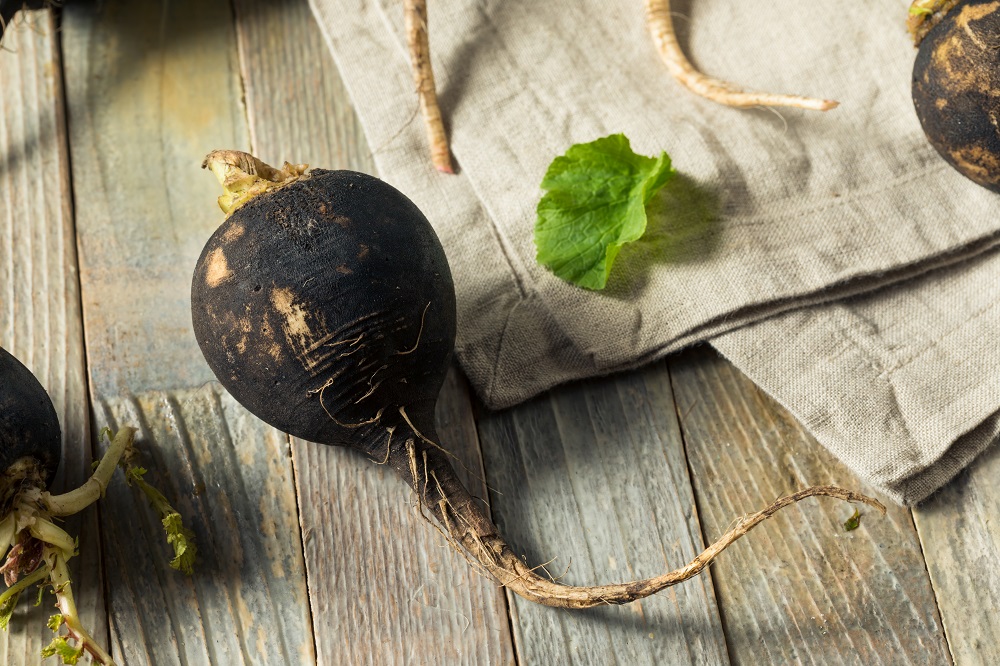Black turnip - properties, purpose, side effects

Black turnip is a vegetable with an intense, spicy aroma that contains significant amounts of valuable nutrients. Thus, the plant can have a beneficial effect on the human body, strengthening immunity and taking care of the proper functioning of the liver.
Summary
What other properties can exhibit black turnip? How can use a vegetable every day?
Black turnip - what is it?
Black turnip, also known as black radish (lat. Raphanus sativus) is a plant belonging to the Brassicaceae family, which can reach 90 cm in height. Its leaves are rough and feathery separated, and they are arranged in the shape of a dense rosette. The stem, which appears at a later stage of development, is distinguished by purple or white flowers. The fruit of the plant, in turn, is an oblong siliqua. Black turnip is a large and bulbous root, which is black on the outside, while on the inside - white and juicy. The plant is distinguished by its pungent taste and smell.
Black radish prefers a temperate climate. It is favoured by sunny places, which are distinguished by loamy and moist soil. Due to its short growing season, it is also often used as an aftercrop. Early varieties of black radish are usually sown at the turn of March and April. Late varieties can be sown in June or July. The cultivation of black turnip was common in the Middle East, Europe and Central Asia as early as the Ancient times. According to the prevailing belief, the black radish was then served to the workers building the pyramids in Egypt to give them strength to perform superhuman efforts.
The plant probably came to Poland during the reign of the Piast dynasty. Although the times of its greatest popularity have passed, it should not be forgotten that in the past it was a basic component of food. However, she lost the fight for favours among the housewives with the potato.
Currently, black turnip in the wild can be found on the coast of the Mediterranean Sea. In Poland, only cultivated varieties of plants are known.
Recommended products
Nutrients of black turnip
Black radish contains many valuable nutrients that can support the proper functioning of the human body. The vegetable has the greatest nutritional value in autumn and winter. Black turnip contains, among others.:
- Sulfur compounds, such as synigrin or glucorafinin,
- phytoncides from the group of glucosinolates, which may have bactericidal activity,
- vitamins - B vitamins, vitamin C,
- minerals such as potassium, iron, calcium, magnesium or phosphorus,
- essential oils,
- anthocyanins,
- phytosterols such as beta-sitosterol,
- glucobrassicin and 4-methoxybrassicin.
In 100 g of vegetables, which contains 33 kcal, can be found:
- 1.1 g of protein,
- 0.3 g of fat,
- 4.7 g of carbohydrates,
- 3.5 g of dietary fiber.
Black turnip - properties
The black turnip can stimulate the secretion of saliva, bile and gastric juice. It can also exhibit strong diuretic and detoxifying properties. The black radish can act bactericidal and antifungal, eliminating pathogenic microorganisms and germs from the body. Thus, the plant can strengthen the body's immunity.
The vegetable can also support the proper functioning of the liver, showing hepatoprotective effects. It can relieve inflammation and promote the secretion of bile, and the active substances present in the plant can participate in the regeneration of the organ.
The black turnip can also take care of the digestive system, supporting the digestive process, as well as showing relaxation effects. The plant can support the removal of excess gases from the body by accelerating intestinal peristalsis. At the same time, it can be helpful in constipation and flatulence. In addition, the vegetable may have a hypolipidemic effect, contributing to a decrease in the concentration of total cholesterol in the blood serum, as well as a decrease in triglycerides. What's more, the plant can affect the increase in the concentration of HDL cholesterol.
The active substances present in black radish can also stimulate blood circulation, facilitate expectoration and have an antirheumatic effect. In addition, the vegetable may have hypoglycemic and antidiabetic effects. The black turnip can also reduce postcibal glycemic load. The properties of the plant may be related to its ability to enhance antioxidant defense and reduce lipid peroxidation, and may also result from its action to improve glucose hemostasis, promote its uptake and energy metabolism, and reducing the absorption of glucose in the intestine. The data suggest that not only can black turnip root work favourably among diabetics, but also its seeds and leaves.
The black radish also contains antioxidant compounds, which means that the plant can contribute to reducing oxidative stress, fighting free radicals and delaying aging processes.
Purpose - what to do with black turnip? How to eat?
The black turnip is used both in the kitchen and in cosmetics or pharmacology.
In the cosmetics industry, the plant is often a component of shampoos and hair conditioners. This is due to the fact that the black turnip can stimulate increased hair growth. In addition, it can strengthen hair roots and make hair shiny and more resistant to drying and damage.
In the kitchen, can prepare a variety of dishes from the black radish. The vegetable is distinguished by an intense and spicy aroma, somewhat similar to garlic, thanks to which it works great as a component of salads. The black turnip can also be used as a stuffing for dumplings or as a base for soup. The plant also tastes good in cooked and baked form.
The black turnip can also be used to prepare juice, which will provide the body with many valuable nutrients, and can also stimulate blood supply to the skin and brighten the complexion. To prepare fresh black radish juice, it is enough to grate the vegetable on a grater, and the liquid squeeze through gauze. The resulting juice can be used orally or externally, to rub sore spots.
From vegetable, can also create a health-promoting tincture. To prepare it, you need to grate the black turnip on a grater, and the resulting pulp pour alcohol in a ratio of 1:5. Then the mixture should be covered and put in a cool place for 14 days, and after two weeks filter and pour into the dish. The tincture can be used orally in small amounts, or externally, for example as a lotion to scalp.
Black turnip - side effects and contraindications
Because the black turnip has an intense, pungent taste and smell, care should be taken by people struggling with gastritis or hyperacidity. Additionally, because the black radish extract may have a detoxifying effect, the plant should not be used by people with chronic kidney disease. The black radish is also not recommended for people with heart failure or catarrhal bowel disease.
The black turnip is a solid portion of vitamins and minerals. When consumed in excess, it can increase the risk of developing stomach hyperacidity. Therefore, it is worth maintaining moderation, including black radish in the daily diet.

